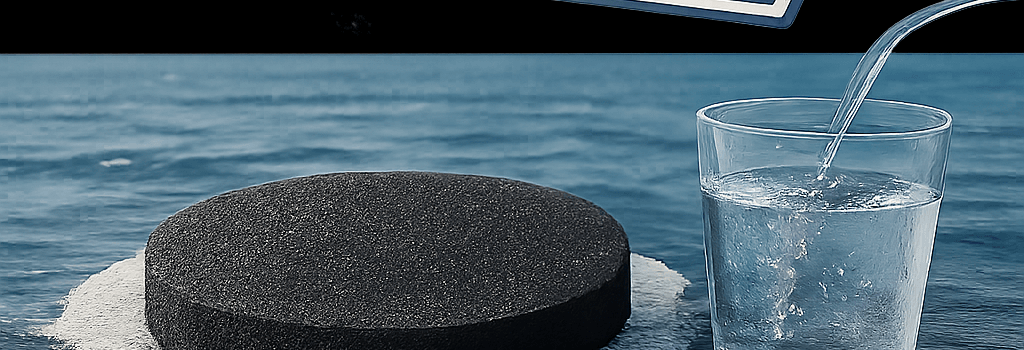Photothermal Aerogels Convert Seawater to Drinkable Water Using Solar Energy

Introduction: Water Scarcity and the Promise of Solar Desalination
Earth’s surface is roughly 71 percent water, yet only 0.3 percent of that is readily accessible freshwater in lakes, rivers, and streams. The remaining supply is locked in glaciers or rendered saline by the oceans. Rapid population growth, climate change, urbanization, and pollution have intensified water scarcity and resulted in inadequate access to safe drinking water for over 2 billion people worldwide. Pathogenic microbes in contaminated supplies cause diseases such as cholera, dysentery, and typhoid, presenting a critical need for decentralized, energy-efficient purification technologies.
Design and Fabrication of the Photothermal Aerogel
Materials and Structural Optimization
Led by Xi Shen at The Hong Kong Polytechnic University, researchers have developed a 3D-printed photothermal aerogel that combines carbon nanotubes (CNTs) for broadband solar absorption and cellulose nanofibers (CNFs) to provide mechanical integrity. The composite uses a mass ratio of CNT to CNF of roughly 1:4, yielding a specific surface area near 85 m₂ per gram and pore diameters in the 5–50 μm range. The aerogel’s lamellar microstructure and thin walls (20–40 μm) localize heat at the liquid‐vapor interface and facilitate fast water transport.
3D Printing and Freeze Casting
The aerogel is fabricated via a layer-by-layer extrusion process. A paste containing dispersed CNTs and CNFs is extruded through a 200 μm nozzle onto a substrate held at −20 °C. Each printed layer is immediately freeze‐cast, locking in the lamellar architecture before the next deposition. This cryogenic 3D printing approach prevents collapse of the porous network and ensures uniformity across large areas up to 1 m₂.
Performance Metrics and Experimental Validation
- Evaporation Rate: 1.70 kilograms per square meter per hour under one sun illumination (1 kW/m₂), exceeding typical hydrogel rates (≈1.2 kg/m₂/h).
- Thermal Conductivity: ~0.035 W/m·K, limiting heat loss to bulk water and substrate.
- Mechanical Strength: Compressive modulus of 50 kPa, enabling deployment on floating supports.
- Durability: No performance degradation observed over continuous 7-day outdoor tests.
In bench-scale trials, a transparent cover directs solar flux onto the aerogel surface. Evaporated water condenses on the dome and flows into a collection channel, yielding roughly 3 tablespoons of potable water per cycle. Upscaling to pilot units (0.25 m₂ active area) suggests output of 400 liters per day in equatorial sunlight.
Mechanisms of Photothermal Conversion
The CNT network absorbs 95 percent of incident solar wavelengths from 300 to 2500 nm, converting photons into thermal energy via non-radiative relaxation. The hierarchical pore structure channels saline feedwater by capillarity to the evaporation front, maintaining a thin liquid film (<200 μm). This heat localization approach minimizes conductive losses and achieves surface temperatures near 45 °C under one sun, even when ambient air is 30 °C.
Scalability and Field Deployment
Conventional solar evaporators suffer performance drop-off when scaled due to vapor transport limitations. This aerogel’s interconnected porosity and rigid framework maintain vapor flux even at module sizes exceeding 1 m₂. Ongoing field tests in coastal Southeast Asia will evaluate seasonal variations, biofouling, and real-world maintenance cycles. Early prototypes integrate photovoltaic sensors and IoT monitoring to provide remote performance data via LoRaWAN networks.
Environmental Impact and Lifecycle Assessment
A preliminary life-cycle analysis indicates the aerogel’s low carbon footprint (<5 kg CO₂ eq per m₂) is driven primarily by CNT production. Researchers are exploring biomass-derived nanocarbons and solvent recovery systems to reduce embodied energy. End-of-life strategies include recycling CNF back into pulp and reclaiming CNTs via thermal oxidation.
Comparative Analysis with Existing Technologies
- Reverse Osmosis: High energy demand (3–5 kWh/m₃) and brine discharge challenges.
- Polymer Hydrogels: Effective at small scale but suffer swelling, lower flux (≈0.8 kg/m₂/h), and limited mechanical strength.
- Photothermal Films: Low cost but prone to fouling and require frequent replacement.
The aerogel bridges these gaps by combining high flux, durability, and modular scalability without external power.
“Our next step is multi‐month field trials in remote coastal villages,” says Xi Shen. “We are also collaborating with an MIT research group on hybrid desalination units combining solar evaporation with membrane distillation.”
Outlook and Future Directions
Recent publications in Nature Materials and Joule highlight emerging photothermal composites using MXene nanosheets and graphene aerogels. Integrating these advances with Shen’s 3D printing platform could further boost evaporation rates above 2.0 kg/m₂/h. As sensor networks, AI‐driven predictive maintenance, and modular fabrication converge, solar‐driven desalination using photothermal aerogels may soon transition from lab to large‐scale deployment.